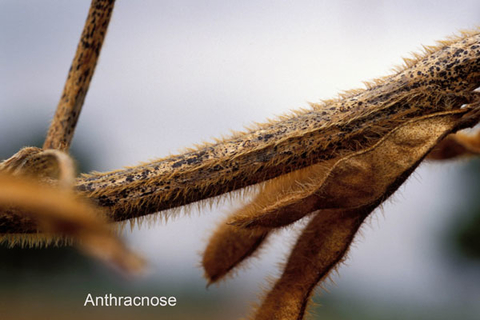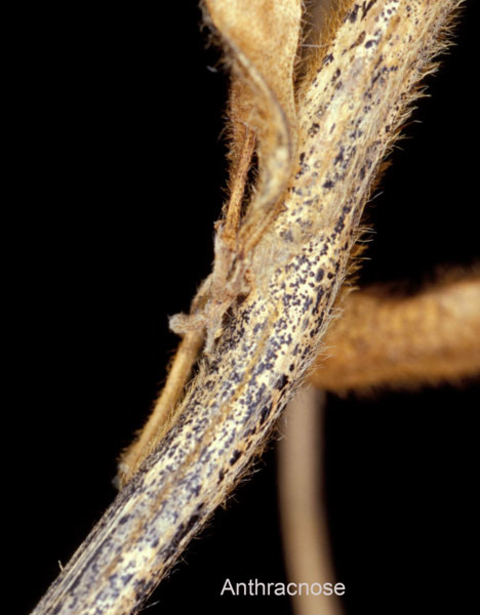Anthracnose is a stem disease that occurs during wet, warm, and humid conditions, although symptoms are often not seen until plants reach maturity. The disease typically has minimal effects on yield, but it can reduce yields, stands, and seed quality. Although the symptoms of anthracnose can be mistaken for pod and stem blight, the symptoms are different and both diseases may be present on the same plants late in the season.
Symptoms
The most common symptoms are seen late in the season as the plants approach maturity. Irregular brown spots develop in a random pattern on stems and pods. The infected areas are covered with tiny black spines (setae) that can be seen with a 10X hand lens. Brown cankers can appear on petioles and cause defoliation. Infection of pods results in few or small seeds per pod. Infected leaves may develop brown veins and curl up. In older plants, the stems, pods, and leaves may be infected without showing symptoms until the weather is warm and moist or plants reach maturity. Infected seeds may have no symptoms or may develop brown or gray areas with black specks. Seeds infected by anthracnose may not germinate. Infected seedlings develop dark, sunken cankers on the cotyledons, epicotyl, and radicle that cause damping-off.
Conditions and timing that favor disease
Warm and moist conditions favor infection and disease development. Plants can be infected at any time during the season, but symptoms often don't appear until plants reach maturity in the upper Midwestern U.S.
Causal pathogen
The primary pathogen that causes anthracnose in the Midwest is the fungus Colletotrichum truncatum, but other fungi may also be associated with anthracnose. This pathogen overwinter in infected crop residue and infected seeds, and may be seedborne. It is a different pathogen than the one that causes anthracnose of corn, however, it has a wide host range that includes alfalfa, ragweed, and velvetleaf.
Disease management
Rotate with a non-legume (non-host) crop. Use pathogen-free seed. Treatment of infected seeds with a fungicide may be beneficial. Fungicidal sprays may be helpful after flowering begins. Soybean varieties differ in their resistance to anthracnose.
Reviewed in 2018



